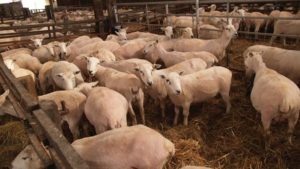Metabolic Blood Profiling Sheep Pre Lambing
18 January 2018What Is It And Why Do It?
 Blood sampling ewes in late pregnancy is a well established tool that will help determine if the ration being supplied in late pregnancy is satisfying the ewes requirements. Ultimately ewe mortality and neonatal lamb mortality is often directly related to the nutrition of the late pregnant ewe. A significant proportion of lamb neonatal death is directly related to ewe colostrum and milk production and this is determined, in part, by ewe nutrition. So it is obvious why many of our clients now see metabolic testing as an essential pre lambing tool.
Blood sampling ewes in late pregnancy is a well established tool that will help determine if the ration being supplied in late pregnancy is satisfying the ewes requirements. Ultimately ewe mortality and neonatal lamb mortality is often directly related to the nutrition of the late pregnant ewe. A significant proportion of lamb neonatal death is directly related to ewe colostrum and milk production and this is determined, in part, by ewe nutrition. So it is obvious why many of our clients now see metabolic testing as an essential pre lambing tool.
When To Do It?
Approximately 3 weeks before the start of lambing. Too early then the ewes are not under enough pressure for problems to be identified – too late there is insufficient time to implement changes pre lambing.
What Sheep Are Tested?
A standard submission of 20 samples is encouraged and the fee is fixed for this number of sheep. Thus in our practice we usually test 6 single carrying ewes, 7 twins and 7 triplets because usually these 3 groups are at this stage being managed and fed differently. Perhaps surprisingly we often find that the single bearing ewes are protein deficient. This always promotes discussion as often these ewes will have a lamb twinned on and rear twins yet it is hard for them to produce enough quality colostrum to give both lambs a good start if they themselves are in protein deficit. One green top vacutainer of blood is all that is required to run all of the following tests.
What Tests Are Done?
Beta hydroxybutyrate (B-OHB) – this compound is produced as a bye product of fat breakdown in the sheep’s liver if she is in negative energy balance. If elevated blood levels are left and the ration not improved then clinical twin lamb disease will result (which if seen clinically is often unrewarding to treat).
Urea N – this is an indicator of current protein intake. Obviously low urea N values in the ewe in late pregnancy will result in suboptimal lamb growth in utero and reduced quality and quantity of colostrum.
Albumin – This is one of the main proteins produced by the liver from dietary protein. Reduced levels of albumin can occur for several reasons such as chronic undernutrition, liver fluke or other chronic diseases such as Johne’s. Ewes with low albumin will not produce enough or good enough colostrum and milk to satisfy the lambs requirements. The ewes may also have a lesser functioning immune system so their response to the pre lambing clostridial vaccination may, for example, be sub optimal.
We had several cases in the spring of 2017 where low blood albumin levels lead us to diagnose chronic liver fluke which in turn was caused by Triclabendazole resistance. On these farms ewes had been dosed into the shed after scanning with Triclabendazole. Assuming that they cannot get re-infected with fluke inside a shed the farmers were happy that liver fluke should not have been a problem. This highlights the importance of checking post treatment that a product has worked by doing a pooled fluke or worm egg count.
Magnesium – As there are no body stores of magnesium a continuous dietary intake is vital, Although clinical staggers is less common in sheep relative to cows we do see it sometimes after lambing. Adequate magnesium levels are also required to regulate calcium levels.
Copper – Copper deficiency is a very rare problem that we encounter in our area and actually measuring blood copper levels are often of more use to check that ewes are not getting too much copper in their diets.
We get results within 48 hours of the samples being submitted to the lab and thus can act on the results very quickly which is vital at this time of year.
Andrew Robinson, Hawick Veterinary Practice
Sign up to the FAS newsletter
Receive updates on news, events and publications from Scotland’s Farm Advisory Service
